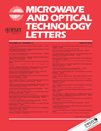Silicon electrooptic ring modulator fabricated by a standard complementary metal oxide semiconductor process
Abstract
An electrooptic (EO) modulator incorporating silicon ring resonators has been proposed and demonstrated using a standard complementary metal oxide semiconductor silicon-on-insulator technology.It consists of a bus-coupled ring resonator integrated with a p–i–n junction, involving a grating coupler attached to either end of the bus for light coupling. The EO modulation is accomplished by shifting the band-stop resonance of the ring via the plasma dispersion effect, which is triggered via the p–i–n junction. The fabricated device was characterized in terms of its guided mode, spectral response, and EO modulation. The resonator functioned as a periodic band-stop filter with a Q factor of ∼25,700 at ∼1544 nm; its resonance was displaced with a rate of 0.3 pm/μA. Thus, we have achieved an affordable modulation of more than 10-dB extinction for an applied current of 85 μA. Finally, a high-speed digital signal beyond 300 Mbps was successfully transmitted through the device to attain a decent eye pattern. © 2012 Wiley Periodicals, Inc. Microwave Opt Technol Lett 54:789–794, 2012; View this article online at wileyonlinelibrary.com. DOI 10.1002/mop.26650




